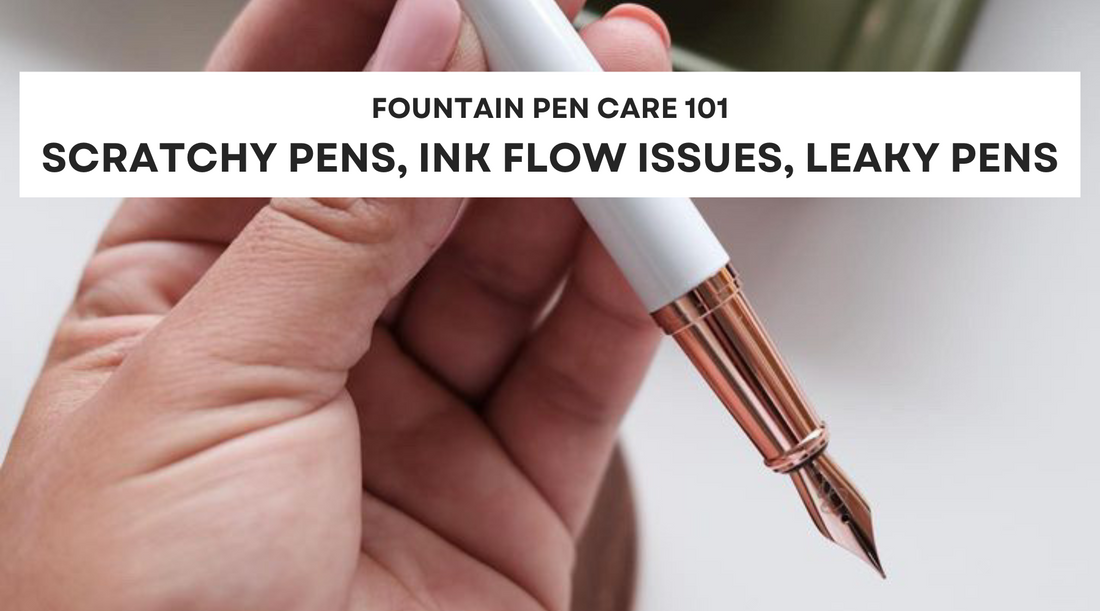Fountain pens are beloved writing instruments that offer a smooth and luxurious writing experience. However, like any tool, they can sometimes encounter issues that may frustrate even the most dedicated pen enthusiasts.
Fear not, as we're here to help! In this blog post, we'll guide you through some common fountain pen problems and provide useful tips to resolve them.

Scratchy Nib
One of the most common issues faced by fountain pen users is a scratchy nib. If your pen is scratching or catching on the paper instead of gliding smoothly, try the following solutions:
Check the alignment of the tines: The tines of the nib should be aligned properly to ensure a smooth writing experience. Gently press the tines together or pull them apart until they align evenly. Be cautious and make small adjustments at a time.
Polish the nib: Sometimes, a scratchy nib can be caused by rough spots on its surface. You can use a micro-mesh pad or a brown paper bag to gently polish the nib and smooth out any imperfections. Remember to be gentle and take your time while doing this to avoid causing further damage to the nib.
Consult the experts: If you've tried aligning and polishing the nib but the scratchiness persists, it might be best to seek professional assistance.
Ink Flow Issues
A pen with inconsistent or no ink flow can hamper your writing experience. To resolve ink flow problems, try these steps:
Clean the pen: Over time, ink residue and debris can accumulate in the pen's feed, causing clogs and impeding ink flow. Use a pen flush solution or lukewarm water to flush out any dried ink or debris from the feed. Follow the manufacturer's instructions or seek guidance from Ellington Pens for proper cleaning techniques.
Prime the feed: After cleaning the pen, it's essential to prime the feed to ensure a steady ink flow. You can do this by dipping the nib into ink or using a converter to draw ink into the feed. This process helps establish a continuous flow of ink and resolves any potential flow issues.
Choose the right ink: Different fountain pens may perform better with certain types of ink. Some inks may be too thick or dry for specific pens, leading to flow problems.
Leaking or Burping
A leaking or burping pen can lead to messy ink stains and interrupt your writing flow. Try these remedies to address the issue:
Check the cap: Ensure that the cap is tightly secured to prevent air pressure changes that could cause leaks. If the pen has a threaded cap, make sure it is screwed on tightly. For snap-on caps, make sure they click securely into place.
Store the pen horizontally: If possible, store your pen horizontally when not in use. Storing the pen in an upright position can cause the ink to pool near the nib, leading to leaks or burping. By storing it horizontally, you minimize the chances of ink leakage due to gravity.
Avoid extreme temperature changes: Rapid temperature changes can cause the ink to expand or contract, leading to leaks or burping. Keep your pen away from extreme heat or cold. For example, avoid leaving it in a hot car or exposing it to direct sunlight for prolonged periods. If you anticipate extreme temperature changes, consider carrying the pen in a protective case.
Skipping or Hard Starts
Skipping or hard starts occur when the pen fails to write immediately or leaves gaps in the writing. To tackle this issue, try the following solutions:
Check the ink level: Ensure that the pen has an adequate ink supply. Low ink levels can cause skipping as the ink may not flow smoothly. Refill the pen or replace the cartridge to ensure a sufficient ink supply.
Store the pen correctly: Keep the pen capped when not in use to prevent the ink from drying out. Leaving the pen uncapped for extended periods can cause the ink to evaporate, resulting in hard starts. By keeping the pen capped, you maintain a moist nib, ready for writing whenever you need it.
Adjust the nib position: If the pen experiences hard starts, you can try slightly adjusting the nib's position by rotating it in the pen's section. Sometimes, a minor adjustment can improve ink flow and reduce skipping. Be cautious and make small adjustments, testing the pen after each change to find the optimal position.
Consider Ellington Pens' offerings: Ellington Pens carries a variety of pens with high-quality nibs designed to provide a consistent and reliable writing experience.

While encountering fountain pen problems can be frustrating, with a bit of troubleshooting and the right techniques, most issues can be resolved. Remember to take care of your fountain pen by keeping it clean, using suitable ink, and storing it properly.
By following these tips, you'll be able to maintain a smooth and enjoyable writing experience with your fountain pen. And for an exceptional writing experience and a wide selection of quality fountain pens, we recommend checking out Ellington Pens. Happy writing!

